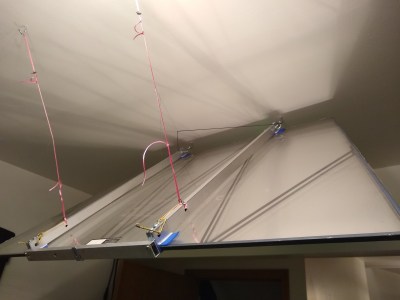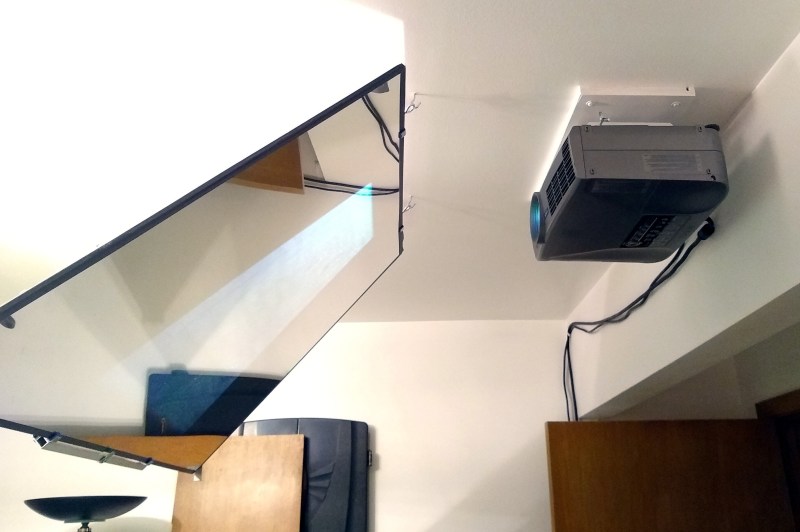It’s fantastic that we’re living in the age of downloadable PDF patterns, it really is. But printing out a bunch of sheets of paper and taping them together is a tedious and tiresome process that can introduce error right from the start. This goes for any type of pattern, from sewing to R/C planes.
 [Quinn]’s quarantine project is designed to cover both of those and everything in between. It’s a pattern projector made from stuff already on hand — a couple of offset projectors to scavenge parts from, and a large, trapezoidal mylar mirror from an old rear projection TV. At maximum zoom it projects a 4′ x 3′ image onto the tabletop, which sounds perfect for a whole lot of sewing patterns. At minimum zoom, the projected image fits on a foam core board.
[Quinn]’s quarantine project is designed to cover both of those and everything in between. It’s a pattern projector made from stuff already on hand — a couple of offset projectors to scavenge parts from, and a large, trapezoidal mylar mirror from an old rear projection TV. At maximum zoom it projects a 4′ x 3′ image onto the tabletop, which sounds perfect for a whole lot of sewing patterns. At minimum zoom, the projected image fits on a foam core board.
We love that this dreamy setup can be stowed away so easily on hooks in the ceiling. [Quinn] had to perform a few hacks to make it all work together, including fabricating a bracket and some adjustable ties to hold the mirror aloft at just the right correct angle.
Need something smaller? Check out this Pi-powered pocket projector. Want a cinema-quality setup? You just have to find the right auctions.

















My fabric maker (seamstress) wife would have liked to see an application of a projected pattern in use.
You might point her over here https://www.facebook.com/groups/ProjectorsForSewing/
Lots of examples
thanks!
Sometime I’d like to play around with this kind of setup and the old blueprint (cyanotype) process… or see if there’s anything similar that can be done with “common household chemicals” i.e. stuff you can still get at walmart without anyone thinking you’re making meth or explosives.
I used my home theater projector for marking a sheet of plywood to clamp the parts for the metal frame of a couch I was working on – it was cool to project Fusion directly and make changes to something life size to see how it all looked in “real life”. I never thought of picking up a cheapo projector to do the same thing for the other odd projects I do. It takes roughly forever to get my ceiling mounted projector back to perfect after moving it, so I never use it.
I did the caveman version of this just last week: put a sheet of foam up on the wall, aimed projector right at the center, and traced a pattern with a sharpie. This is 100% more convenient. Cool hack.
Plus, mylar mirror!
Does anyone have suggestions for simplifying tracing existing patterns onto new material?
My mom’s group of fabric crafters have some old patterns that they’re trying to duplicate since the old patterns are getting brittle with age.
I was going to build a 3’x4′ light table, but if someone has a better suggestion, I’m open to options.
not really in the spirit of the site, but i just took my patterns down to officeworks where they have a good quality large format scanner.
anything i did at home suffered from parrallex
This sounds like a job for …. Captain Digitiser !!! So, yah, some kind of large format digitiser so you can get points into the computer, to some marginally capable 2D CAD format, then print new ones on a plotter or other output device. However, there are software digitisers where you can mark points on a photo and enter dimensions and it will figure it out. But if we’re talking like 2 patterns, trace over them on parchment paper.
It sounds like they ended up with a collections of patterns that the club inherited from an elderly member who recently passed away.
Most of these are burlap with black lines, so poor contrast for doing optical digitization without a lot of manual assistance, and all in the larger size ranges.
It sounds like they’re going to keep doing it by hand, as they are all perfectly capable of tracing lines, and none apparently interested in learning the computing skills needed to digitize them.
Yeah, if you have the space, a large light table can simplify the tracing, and is easy for a long time sewer. Requires the original pattern allows light to go through, though most do.
Lot of CoreXY principles where listed here so why to no repeat the Core Idea from MIT Design lab behind Fabric Plotter..
link: http://www.corexy.com/botofthecloth/index.html
That’s a neat project. I wonder what they use for marking, and how they keep the fabric to be marked from sliding when running the pencil over it. (I can’t find any pictures or videos of it drawing on a piece of fabric